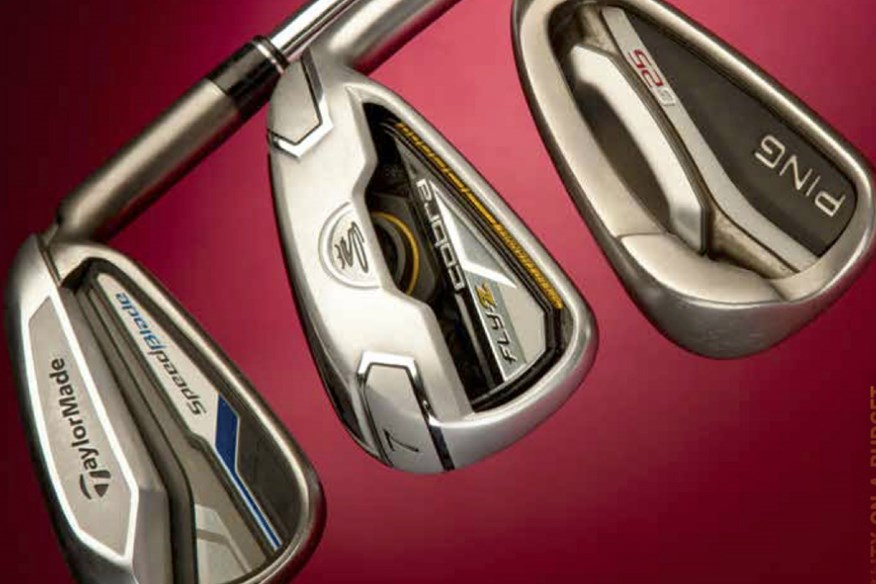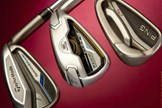What are the best irons you can get for under £300?
Published:
At TG we are constantly testing the latest clubs and technology. But with a new set of irons setting you back about a month’s mortgage payment, we know many of you will be looking to keep the costs down when it comes to an upgrade.
So for £300 – half the cash of an average new set of irons – how good a set of irons could you bag yourself? Could year-old technology hold its own against the latest innovations on the market? And can you, armed with a keen eye and a little knowledge, bag a set for less than £300 that will keep your handicap tumbling and your wallet happy?
THE TEST
We teamed up with GolfBidder.co.uk to source the best range of second-hand irons from the leading manufacturers we could find. We asked our test pro Chris Ryan to hit 7-iron from each set on a SkyTrak launch monitor at The National Custom Fit Centre at The Belfry.
Callaway X Hot Pro, £262
Cost when new – £699
Launched – 2013
Ball speed – 172mph
Carry distance – 190 yards
The Pro heads are a little smaller and less offset than the standard X Hot irons. There’s a J-shaped face construction and undercut cavity to increase flex low on the face and stiffen up the top for fast ball speeds and maximum distance. Ours came with non-standard True Temper GS 95 steel shafts.
We say…
As far as head shapes go the X Hot is very strong. There’s a decent-sized undercut cavity which is teamed with a reasonably thin top edge and a small amount of offset which we reckon will suit a reasonably confident
Our verdict…
For someone these are a sound investment. They boast face and cavity technology but we reckon any buyer will need to invest in a re-grip as their current grips have been fattened up and the originals are pretty shiny. The condition isn’t fantastic but the price reflects that. If you’re looking to upgrade and don’t need full-on game improvement technology they could be worth a try.
TaylorMade SpeedBlade, £277
Cost when new – £599 (steel); £699 (graphite)
Launched – 2013
Ball speed – 129mph
Carry distance – 195 yards
A Speed Pocket in the sole of the 3 to 7-irons along with inverted cone technology behind the face helps increase flex to maximise ball speeds and distance, no matter where you hit shots on the face. Individual designs ensure consistent gapping.
We say…
The SpeedBlade is only a couple of years old but in our opinion they’re still a fantastic looking set of irons. The set we had were in very reasonable nick for the sub £300 price tag, with their original
TaylorMade grips (which could probably do with a re-grip) and lightweight 85g steel shafts intact. Ok the tech’s not quite as up to date as the M2 or PSi but they put in a serious shift and could pretty much match the current M2 shot for shot. For us SpeedBlade is a decent blend of forgiveness and distance, with a good degree of offset in the mid to longer irons to help playability.
Our verdict…
Not only did the SpeedBlade feel really good they also posted some very strong ball speed and carry distance numbers. If £300 is your budget you could do a lot worse, especially if you are a reasonably confident ball-striker.
Cobra Fly Z, £260
Cost when new – £549
Launched – 2015
Ball speed – 124mph
Carry distance – 184 yards
A big unsupported face means extra flex to transfer maximum energy on every shot you hit. A speed channel runs around the sole and face which Cobra say helps maintain ball speed when you don’t hit the centre and a urethane insert in the cavity dampens vibrations to improve feel and sound.
We say…
Fly Z was Cobra’s game improvement iron just last year which just goes to show how quickly equipment can be turned over. These were almost like new. The deep undercut cavity back means a huge amount of forgiveness, but it’s contained within a club that looks really attractive at address. The soles and top edges are not too wide, and there’s a reasonable amount of offset. Fly Z posted the shortest average carry on test (albeit by only a yard) but Chris did record a single 194-yard carry with the 7-iron which was just a yard or two behind the majority of the longest hits with each iron.
Our verdict…
A decent proposition. Not only can they boast up-to-date technology at a reasonable cost, but they’re decent-looking. Custom-fitting would improve their performance, but buying second-hand/online this is less of an option – a drawback worth considering.
Nike Covert 2.0, £258
Cost when new – £449.99
Launched – 2014
Ball speed – 127mph
Carry distance – 191 yards
A large unsupported face eliminates inefficient weight from the face area and redistributes it to the perimeter, increasing playability. A NexCOR face increases flex to maximise ball speeds no matter where you impact shots on the club face.
We say…
This was definitely the biggest iron head we tested. But Nike have a knack of creating game-improvement irons that combine a wider sole and larger head but without huge amounts of offset which experienced golfers seem to warm to. They had been listed as ‘Fair’ on GolfBidder – a realistic reflection of how we found them. The cavity back of the 2.0 is huge which means excellent forgiveness. We thought they launched high (about 1º higher than the others on test) and were incredibly easy to hit. Covert was no slouch either, recording an average just 4 yards behind the longest we hit.
Our verdict…
The Covert performed admirably, and if the irons had been treated a bit more kindly during their previous life they would’ve been a far more attractive set. Despite their all-round competence, their condition meant we reckon there’s probably better options available for your £300.
Benross HTX, £299
Cost when new – £299 (these are brand new!)
Launched – 2016
Ball speed – 126mph
Carry distance – 189 yards
Benross say the faces of the HTX have been heat treated to maximise ball speed and distance. A Torsion Bar on the back increases MOI and stability, making HTX one of the most forgiving irons Benross have ever created. KBS Tour 90 shafts and Golf Pride’s Tour Velvet grips are standard.
We say…
The only set within our test you can buy new for less than £300. And for some having a set of shiny new bats completely wins out over a worn-in set which have already been taught how to misbehave by a previous owner. We really liked the HTX’s head, it’s a blend of a decent size for forgiveness but without masses of offset or a hugely thick chunky top edge. The flight which was powerful thanks to slightly lower spin. Ball speed was on average for all the irons tested and carry distance was slightly ahead of the curve. This is a solid iron.
Our verdict…
Chris Ryan reckoned the HTX could be a perfect match for 99% of weekend golfers. With them being new they can very easily be custom-fit. In our opinion the KBS shafts and Golf Pride Tour Velvet grips are a decent step forward from some of the other components on our test irons.
Ping G25, £214
Cost when new – £80 per club (steel); £100 per club (graphite)
Launched – 2013
Ball speed – 125mph
Carry distance – 185 yards
Ping originally said the G25 were aimed at all golfers, they’ve got generous midsize heads and a whopping big cavity back. A stability bar in the cavity increases rigidity to direct more energy into the ball. A cambered sole aids turf interaction; progressive offset increases playability in the longer irons and shot-making control in the shorter clubs.
We say…
There’s no doubting the 25’s are forgiving and easy to hit, but sit them alongside the new G and they’re like chalk and cheese. No plastic ferrule looks pretty crude and the shaft weighting story of heavier from short irons to long is opposite of what Ping preach with their new AWT shafts in the G. Technology’s moved on since they were launched, with Ping’s new COR-Eye and Hyper steel faces definitely capable of adding extra speed and distance to your game.
Our verdict…
Pings are renowned for holding their trade-in-value but for us technology’s moved on, for £300 we reckon there’s probably better options available. Plus Ping’s custom-fit tradition means there’s a big chance their clubs would be made for someone else, and potentially damaging to your game.
Our advice when looking for irons on a budget
Initially when we organised this test it seemed like a really straightforward, simple mission: Get hold of a load of used irons, test them and decide which we thought were best. But as the irons started arriving and the test got underway the pitfalls of buying second-hand and online hit home. Some of the irons’ grips were worn, some had fatter grips, there was an iron that looked like the lie angle had been tampered with and a shaft length that was longer than the others… oh, and of course you don’t get to hit or handle what you’re buying until it arrives at your front door.
We absolutely are not saying there’s anything wrong with buying used, but it does beg the question of how much of a premium you put on proper fitting. In our book it’s an issue worth considering before opening your wallet. In our opinion GolfBidder offer a fantastic service – let’s face it, they wouldn’t be in business if nobody bought second-hand equipment. Buying second-hand is real life, it’s part of the game, and we reckon some technology available just a couple of years ago is still relevant today and can put in a shift for you for some years to come. Make the right choice and you’ll be buying last year’s irons in as new condition for half what they cost last year. Make the wrong choice and you could be playing a set of irons that really don’t suit your game, hamper your potential and believe it or not actually cost you shots.

